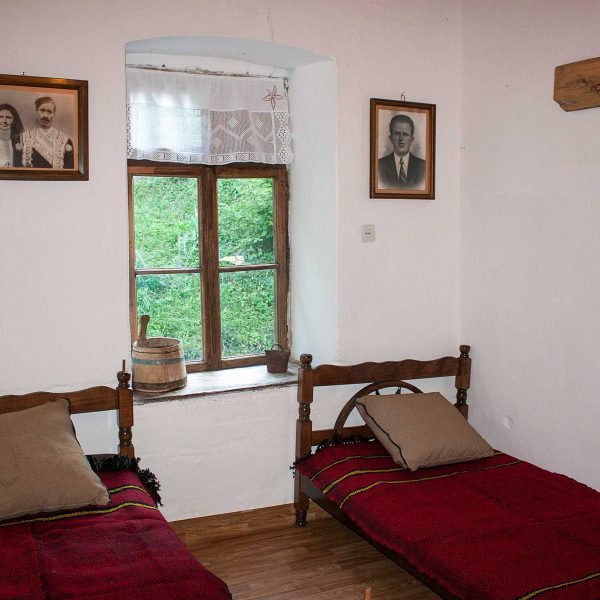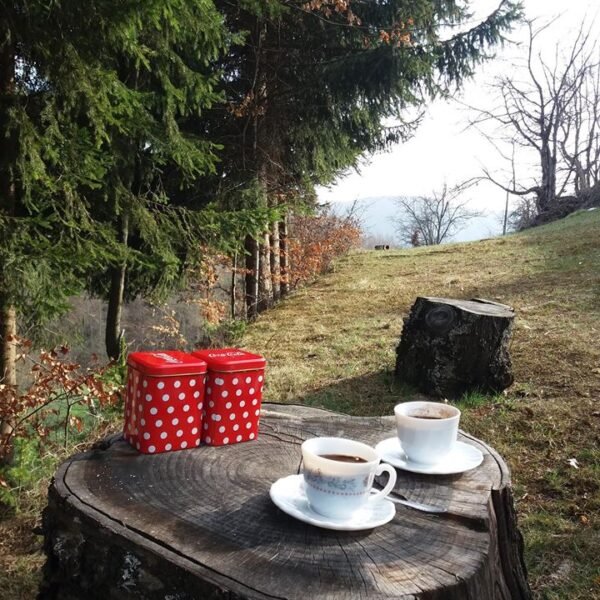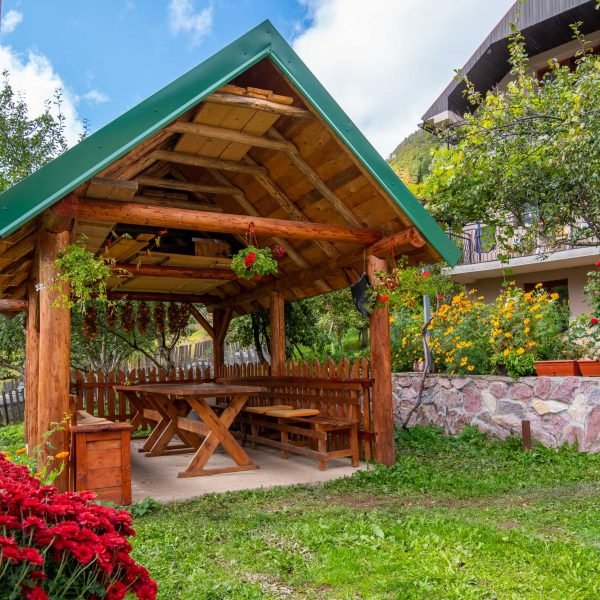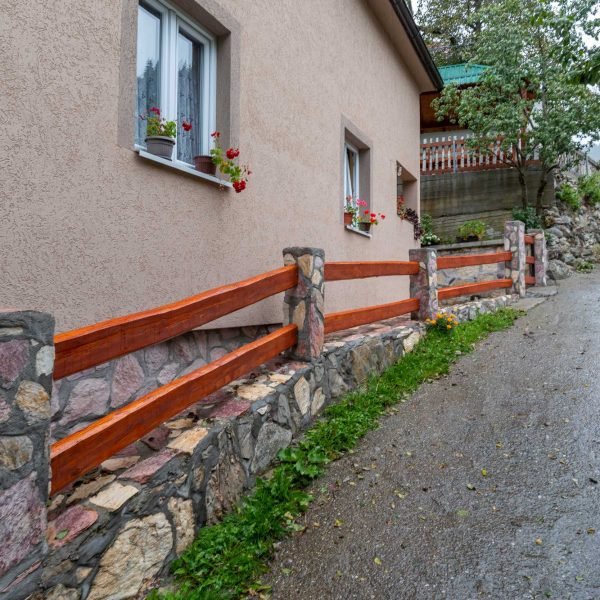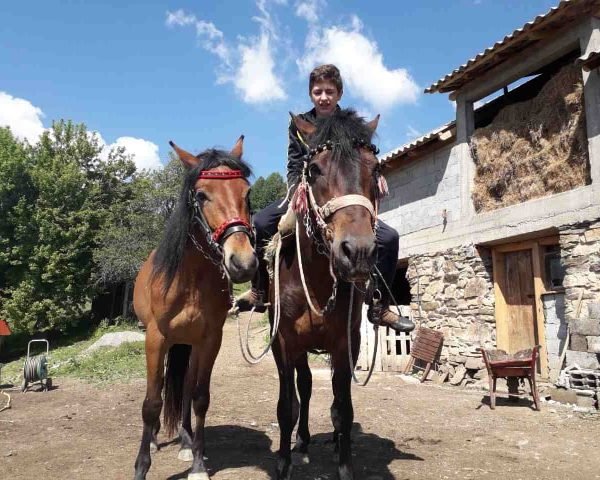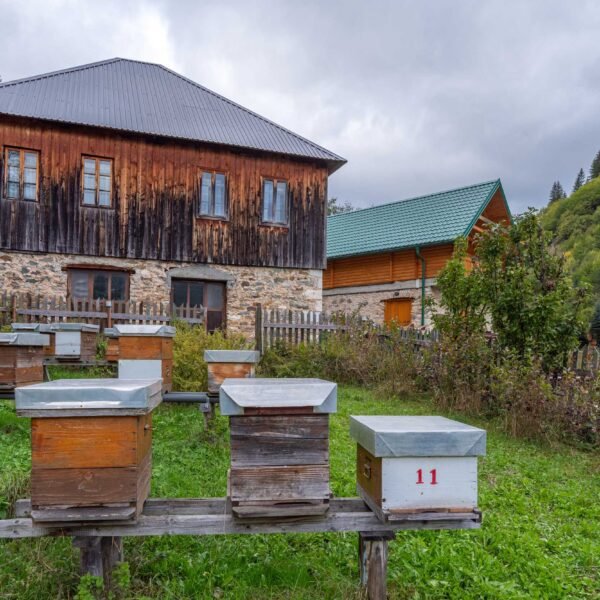Nestled in the picturesque surroundings of Mount Bjelasica, in its most gentle part, lies a group of six villages collectively known as Gornja Sela: Bastahe, Vuča, Glavaca, Kurikuće, Lubnice, and Praćevac. The name originated in the 18th century because these villages are situated “above” Župa. Regardless of their individual names, they were always referred to as Gornja Sela. Over centuries, they shared the fate of Montenegro and its people, evolving into a unified entity that eventually formed Montenegro’s youngest tribe – the Gornjoselsko tribe.
ABOUT THE VILLAGE OF LUBNICE
Our village is the central hub of the Gornja Sela region. Seemingly remote and tucked away, it has endured many hardships throughout history. Our ancestors fought for and protected this land over the centuries. At the end of the 19th century, the border between the Ottoman Empire and the Principality of Montenegro passed through here, meaning that many of our homes were in one country while our lands were in another. A well-traveled caravan route once ran through this area, connecting the Lim Valley with Kolašin.
The people of Lubnice are renowned for their woodworking skills, crafting houses and preserving the tradition of making wooden shingles, barrels, and other wooden containers—a rare craft today. Many authentic old houses remain, making our village well known for its traditional architecture.
ABOUT THE VILLAGE OF KURIKUĆE
Our village is the last permanent settlement before reaching the mountains. According to legend, this is how it got its name: “houses among the wolves” – Kurikuće. Today, it remains the last inhabited village on the way to Biogradska Gora National Park.
It is one of the few villages where traditional folk architecture is still well-preserved. A walk through the village reveals old stone houses and wooden cottages that are still lived in. One of the most beautiful stone houses is the old school building, which the village bought for its children by each household donating a cow.
Our women continue the age-old wool-working traditions of spinning and knitting, just as their mothers and grandmothers taught them. Our cuisine is also traditional and homemade, and you can experience it in one of the households engaged in rural tourism, either in the village or in the summer pastures.
ABOUT THE VILLAGE OF GLAVACA
North of Lubnice, just 15 minutes away, on the steep slopes of Vuča, lies our village, Glavaca, spread on both sides of the Gunjara river. The name, according to local lore, comes from the belief that we were once the “head” of the entire surrounding area. We may not have mountains, but we have excellent pastures around and above our village. We irrigate a small portion of our fertile land, while our drinking water comes straight from the springs. Where else can you find that!
KATUNS ON BJELASICA
In our summer pastures, locals welcome visitors to traditional Katun huts scattered across the slopes of Bjelasica. The huts are mostly built in the traditional style, as our ancestors did for generations. We’ve told you enough—we hope you’ll discover the rest on your own and enjoy the journey.
We wish you a pleasant stay in our villages!
After the German attack on Poland in 1939, a large protest rally was held at Biogradsko Lake. Following the capitulation of the Kingdom of Yugoslavia in April 1941, Montenegro was occupied by the Italian army. Armed resistance was carefully prepared and began with the July 13 Uprising.
In Lubnice, the uprising started on July 16, 1941, with an attack on the local gendarmerie station. The attack on Berane saw rebels from all over the district participating, regardless of party or ideology. As in old Montenegrin warfare, mothers, wives, and sisters followed the fighters, carrying essential supplies—mainly clean cloths instead of bandages and food. Around 5,000 people joined the uprising. Italian soldiers and Carabinieri surrendered, and a People’s Liberation Committee was formed—the only executive authority in occupied Yugoslavia. Soon after, a German expedition regained control.
The victory in Berane boosted morale, but after the Partisans’ heavy defeat in Pljevlja, the resistance fractured. This marked the start of ideological conflicts in Montenegro and Gornja Sela. One dark episode was the execution of 42 captured Partisans.
Partisan units withdrew into underground shelters built in many locations, one of which is part of this memorial site. To crush the resistance, German and Italian aircraft bombed villages to intimidate the people and expose the Partisans. Lubnice was bombed six times. Luckily, there were no casualties, but nearly two-thirds of the village was destroyed.
Berane and the region were finally liberated on September 15, 1944.
The names of Lubnice’s warriors and victims of fascist terror, inscribed on the marble plaque, speak most eloquently of their sacrifice. They gave their lives so that others could live in freedom.
Life and customs in the Upper Villages do not differ much from the rest of the Montenegrin population. The settlers merged their traditions with the way of life of the local inhabitants and the customs of the neighboring Vasojevići. Until World War II, customs were highly respected, guided by the old saying: “Better for the village to perish than the customs.” This thought was the guiding principle of every family in preserving family ties and moral principles.
Family and family cooperatives were the basic cells of society. The average family had 7–8 members, while cooperatives had over thirty. The eldest male member was at the head, and his word was respected without question. Property belonged to the entire community, but the elder was its undisputed master. According to customary law, women had no right to inheritance. Children obeyed their parents and elders without question, and the elder enjoyed lifelong respect.
The role of women was extremely demanding. In addition to caring for the household, she prepared winter supplies, supervised shepherds, worked in the fields, wove clothes, and made footwear. It was said: “A house does not stand on the ground but on a woman.” This did not imply degradation but a necessary division of labor in harsh conditions. If the elder died, the widow took over his role. Women were respected and protected, and a brother was their lifelong guardian. French consul Ekar wrote in 1810 that Montenegrins were ready for revenge over the slightest insult to their women.
The birth of a male child was a special joy. Gunshots were fired, while daughters were said to be “someone else’s fortune.” If a family lost male children, the next son would be named Vuk or Vukašin, believing that evil spirits could not harm a “wolf” name. Boys participated in hard work and received their first rifle by the age of 12–14. By 18, they served in village troops.
Until the late 19th century, marriages were arranged without the consent of the bride and groom—fathers made the decisions. Young people could see each other at gatherings and village fairs. Marriage had a clear purpose—love, respect, offspring, and care for elderly parents. After the wedding, the bride stayed in the groom’s home until younger brothers started their families.
Every brotherhood celebrated its patron saint’s day, a holiday of clan identity. On that day, everyone was welcome in the host’s home. The ritual included baking ceremonial bread, cooking wheat, and lighting a candle, and the celebration was passed from father to son.
Houses were mostly built from spruce wood, with stone foundations and shingle roofs. The simplest were single-story, while more complex ones had a basement for food storage. At the center of the household was the hearth, a symbol of warmth and unity, around which families gathered, told stories, and passed down traditions from generation to generation.
This way of life, though nearly vanished today, has left an indelible mark on the collective memory of the Upper Villages’ inhabitants, who still proudly cherish memories of their ancestors and their way of life.
CHURCH OF SAINT JANJA
In the area of the old village cemetery, during 1999, archaeological research uncovered the remains of the Church of Saint Janja, which were then protected and preserved. It is believed that the church was built in the late 15th or early 16th century, as evidenced by the remains of its plinth and preserved traces of frescoes. The church measured 13.5 meters in length and 6.35 meters in width, while the apse had a radius of 1.5 meters. An unusual feature of the church was its movable altar, as no traces of solid material were found in the foundation of the partition wall. Covered with wooden shingles, the church did not retain its original roof. Historical sources state that stone slabs used for the construction of both this church and the Đurđevi Stupovi Monastery were transported by horses from Vodotres.
The Church of Saint Janja was the spiritual center of the Gornjoseljani community, where believers gathered throughout history. In numerous wars and uprisings, the church was often damaged, but locals would always restore it once the danger had passed. According to legend, in the 19th century, monk Milan Obradović, during a time of great peril, transferred church treasures to the Brezojević Church, from where they allegedly ended up in the Patriarchate of Peć or the Prizren Seminary. To this day, it remains uncertain where these artifacts are located.
THE LEGEND OF JANJA’S LAND
Not far from the church ruins lies a vast ecclesiastical estate known as Janja’s Land. Art historians speculate that a female monastery once stood on this site, though no precise records of its founding exist. Legend says that Janja, the sister of the infamous Jerina, lived there as an ascetic, repenting for sins and earning a saintly reputation. The monastery’s land was cultivated by villagers, who contributed a portion of their yields to the church, and there are no written records proving that they had independent land ownership. It is presumed that all local estates belonged to the monastery.
THE SACRED TREE OF THE OLD ASH
Beside the remains of the Church of Saint Janja stands an ancient ash tree, which the people of Lubnice consider sacred. Of undetermined age, this monumental tree has inspired reverence and awe for centuries. It is believed that damaging it brings great misfortune, a belief reinforced by numerous local tales of calamities befalling those who desecrated it. Due to its cultural and natural significance, the old ash tree is listed as a protected natural monument.
To the northwest of the village of Lubnice, above the Vodotres katun, rises the imposing rock known as Žuta Platija. Behind its massive cliffs lies a natural gem – Udovinjica, a gorge with steep, almost vertical cliffs forming a natural passage. From its center, a magnificent view of Lubnice unfolds, while the entrances to the gorge, hidden in a dense beech forest, add an aura of mystique and allure to this place.
According to legend, Udovinjica was named after a tragic event in which members of the Obradović brotherhood were surrounded and killed, leaving behind numerous widows. Today, this place stands as a silent witness to difficult times and a lasting reminder of the fate of ancestors.
At the foot of Udovinjica lies the Vodotres katun, known for its exceptionally powerful source of cold, potable water. This spring, after which the katun was named, is so strong that it sometimes causes the ground to tremble. Once an important summer settlement for Lubnice herders, it is now abandoned, but its huts still testify to the region’s rich pastoral tradition. The spring is a perfect resting spot for hikers and nature lovers, especially during hot summer days when it offers refreshment with its crystal-clear and icy water.
According to local elders, herders once used Udovinjica gorge as a natural corral to protect their livestock from wolves that roamed the area at night.
A circular hiking trail passes through Udovinjica, leading from the village of Lubnice, over the Vodotres katun, through the gorge, then across Pojatište, and back through forested slopes to the village. This route offers nature enthusiasts a chance to explore the unique landscapes of Bjelasica, while also extending towards the peak of Crna Glava (2139 m), which provides a spectacular panoramic view of the entire region. Hiking enthusiasts and adventurers can enjoy this dynamic and diverse trail, which combines untouched nature, cultural heritage, and unforgettable viewpoints.
Udovinjica has been recognized as one of Montenegro’s outstanding natural treasures and was included in the “All Wonders of Montenegro” project in 2016, organized by the Ministry of Tourism.
Across the river and canyon, on a rocky cliff, lies Župan Cave, the longest cave in the municipality of Berane. Situated on the hill of the same name, at an altitude of 1205 meters, the cave extends 1160 meters in length and reaches a depth of 22 meters. The entrance is 20 meters wide, while its main corridor stretches 100 meters. The interior consists of numerous passages, one filled with water, while some remain unexplored. Particularly significant is the discovery of prehistoric cave bear remains, a unique subspecies found nowhere else in the world.
Visiting the cave requires a speleological guide, which can be arranged through the Tourist Organization of Berane. There are no marked trails leading to the cave, and entry is only possible with the assistance of professional speleologists.
The legend of Župan Cave dates back to the time when Slavs and Romans lived in the valleys of the Tara and Lim rivers. According to the records of Pop Dukljanin, the conflict between the Slavic Župan Ljutomir and the Roman Pavlimir-Bela was the key event that gave the cave its name. Roman Župan Pavlimir-Bela, who ruled from the Samograd fortress three kilometers away, took refuge in the cave to escape an attack.
Slavic prince Ljutomir, camping on the plateau opposite the cave, devised a plan to drive out Pavlimir-Bela. He ordered his soldiers to cut down the forest around the entrance and set it on fire, letting thick smoke spread inside, suffocating those hiding within. At that moment, Pavlimir-Bela’s wife, who was also Ljutomir’s sister, begged her brother to allow her to leave the cave with servants and belongings. Ljutomir agreed, unaware of her plan – she hid her husband in a large chest and carried him out of the cave.
However, the prince soon grew suspicious and caught up with the procession. Upon opening the chest and discovering Pavlimir-Bela, he immediately executed him. The surviving soldiers in the cave perished, and the story of this event continued to be passed down through generations.
From the conflict of the two Župans, only memories remain, along with the cave’s name and the hill that still bears the same title, preserving the traces of an ancient past and the secrets of one of the most fascinating legends of this region.
The Bjelasica lakes, part of the Biogradska Gora National Park, established in 1952, are a natural treasure featuring primeval forests, mountain peaks, and glacial lakes formed during the last Ice Age. The park spans 5,650 hectares and includes lakes such as Biogradsko Lake, Šiško Large and Small Lakes, Ursulovačko Large and Small Lakes, Pešića Lake, and Ševarinsko Lake, each with unique significance.
Biogradsko Lake, at 1,094 meters, is the largest, covering 23 hectares. Surrounded by beech, fir, and spruce forests up to 500 years old, it is fed by streams like the Biogradska River. Its clear water reflects Bjelasica peaks, such as Crna Glava (2,139 m), and hosts trout and various plants.
Šiško Large Lake, at 1,660 meters, spans 4 hectares, while Šiško Small Lake, at 1,777 meters, is smaller. Encircled by alpine meadows and rocks, these lakes attract hikers with their wild beauty and tranquility.
Ursulovačko Large Lake, at 1,838 meters, covers 3 hectares, while the smaller one is lower and more modest. Their dark water, due to glacial sediments, and rocky surroundings highlight their rugged nature.
Pešića Lake, at 1,700 meters, spans 2 hectares. Surrounded by pastures, it draws deer, foxes, and shepherds grazing cattle in summer.
Ševarinsko Lake, at 1,500 meters, is vanishing due to eutrophication. Once 1 hectare, it is now a marsh overgrown with reeds and aquatic plants, evidencing the natural lake cycle.
These lakes, part of Bjelasica’s glacial heritage, are preserved within Biogradska Gora National Park as a refuge for rare species and an oasis of untouched nature. Visit them with respect for this ecosystem.
The special value of these lakes lies in their diversity and ability to sustain life in extreme conditions. From the deep waters of Biogradsko to the fading Ševarinsko, each lake tells a story of geological change and nature’s adaptation, making this park a must-visit for nature and science enthusiasts.
*Listed are rural households that are members of our association and are featured on this site. For other accommodation providers in this area, check Google Maps or Booking.com.
- BJELASICA (ORLJI KRŠI, CRNA GLAVA)
- JELOVICA – PADEŽA – TUSTA – MICAN – ZEKOVA GLAVA – PRIJEKI SMET – GUSINJSKA RUPA – JELOVICA
- HIKING TRAIL LUBNICE – UDOVINJICA – KURIKUĆE – NJEVAŠTICA CAVES
- LAKE ROUTE
- CRNA GLAVA (STRMENICA) FROM SUVODOL
- LUBNICE – UDOVINJICA – CRNA GLAVA
- UDOVINJICA
- TWO HEADS AND FIVE LAKES ROUTE
- JELOVICA – PADEŽA – TUSTA – MICAN – ZEKOVA GLAVA – PRIJEKI SMET – GUSINJSKA RUPA – JELOVICA
- KATUN ROADS
PHOTOGRAPHY
Villages Included in the Project
Project
The Regional Development Agency for Bjelasica, Komovi, and Prokletije (RRA BKP), in collaboration with its partners—the Municipality of Peć (Kosovo) and the Regional Development Agency WEST (Kosovo)—implemented the project “Turning Our Villages into Tourist Destinations” under the IPA II Cross-Border Cooperation Program Montenegro – Kosovo 2014–2020.
Through this project, selected villages in the regions of Plav, Andrijevica, Berane, Bijelo Polje, Mojkovac, and Bar saw improvements in tourist infrastructure. The initiative established thematic rural trails linking natural and cultural attractions, installed signage, information boards, and markers for villages and locations, and supported certain rural households in enhancing their conditions for offering tourism services. As a result of the project, a joint promotional brochure was created, incorporating new thematic rural routes and local offerings, along with promotional video material.
Additional information about the villages
TOURIST ORGANISATION BERANE
+382 51 236 664
toberane@t-com.me

